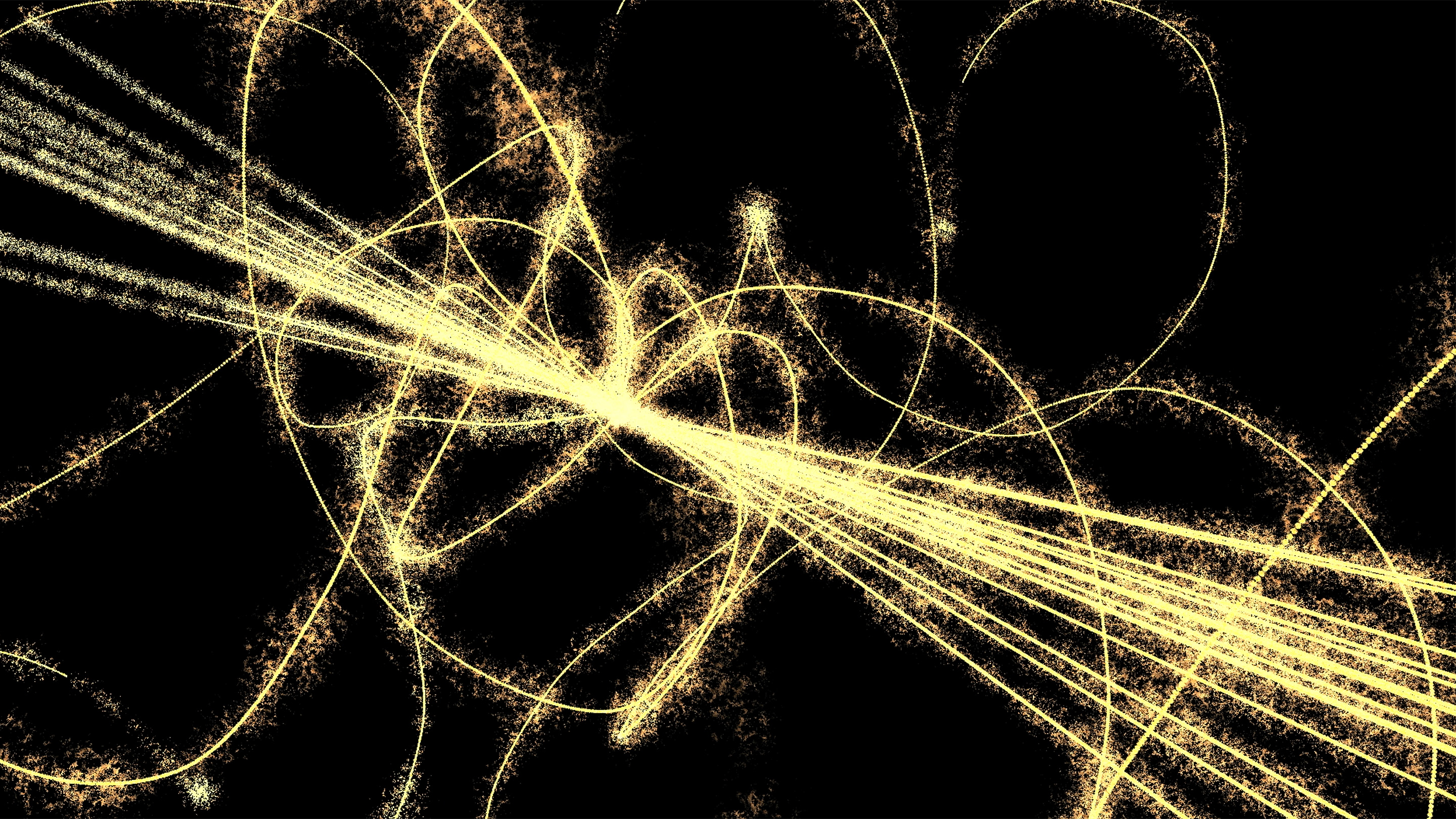The Algorithm That Lets Particle Physicists Count Higher Than Two
Introduction
Thomas Gehrmann remembers the deluge of mathematical expressions that came cascading down his computer screen one day 20 years ago.
He was trying to calculate the odds that three jets of elementary particles would erupt from two particles smashing together. It was the type of bread-and-butter calculation physicists often do to check whether their theories match the results of experiments. Sharper predictions require lengthier calculations, though, and Gehrmann was going big.
Using the standard method devised more than 70 years ago by Richard Feynman, he had sketched diagrams of hundreds of possible ways the colliding particles might morph and interact before shooting out three jets. Adding up the individual probabilities of those events would give the overall chance of the three-jet outcome.
But Gehrmann needed software just to tally the 35,000 terms in his probability formula. As for computing it? That’s when “you raise the flag of surrender and talk to your colleagues,” he said.
Fortunately for him, one of those colleagues happened to know of a still-unpublished technique for dramatically shortening just this kind of formula. With the new method, Gehrmann saw terms merge together and melt away by the thousands. In the 19 computable expressions that remained, he glimpsed the future of particle physics.
Today the reduction procedure, known as the Laporta algorithm, has become the main tool for generating precise predictions about particle behavior. “It’s ubiquitous,” said Matt von Hippel, a particle physicist at the University of Copenhagen.
While the algorithm has spread across the globe, its inventor, Stefano Laporta, remains obscure. He rarely attends conferences and doesn’t command a legion of researchers. “A lot of people just assumed he was dead,” von Hippel said. On the contrary, Laporta is living in Bologna, Italy, chipping away at the calculation he cares about most, the one that spawned his pioneering method: an ever more precise assessment of how the electron moves through a magnetic field.
One, Two, Many
The challenge in making predictions about the subatomic world is that infinitely many things can happen. Even an electron that’s just minding its own business can spontaneously emit and then reclaim a photon. And that photon can conjure up additional fleeting particles in the interim. All these busybodies interfere slightly with the electron’s affairs.
In Feynman’s calculation scheme, particles that exist before and after an interaction become lines leading in and out of a cartoon sketch, while those that briefly appear and then disappear form loops in the middle. Feynman worked out how to translate these diagrams into mathematical expressions, where loops become summing functions known as Feynman integrals. More likely events are those with fewer loops. But physicists must consider rarer, loopier possibilities when making the kinds of precise predictions that can be tested in experiments; only then can they spot subtle signs of novel elementary particles that may be missing from their calculations. And with more loops come exponentially more integrals.
Quanta Magazine
By the late 1990s theorists had mastered predictions at the one-loop level, which might involve 100 Feynman integrals. At two loops, however — the level of precision of Gehrmann’s calculation — the number of possible sequences of events explodes. A quarter century ago, most two-loop calculations seemed unthinkably difficult, to say nothing of three or four. “The very advanced counting system used by elementary particle theorists for counting the loops is: ‘One, two, many,’” joked Ettore Remiddi, a physicist at the University of Bologna and Laporta’s sometime collaborator.
Laporta’s method would soon help them count higher.
Using machines to predict real-world events captured Stefano Laporta’s imagination early. As a student at the University of Bologna in the 1980s, he taught himself to program a TI-58 calculator to forecast eclipses. He also encountered Feynman diagrams and learned how theorists used them to predict how the churn of ephemeral particles hampers an electron’s path through a magnetic field — an effect called the electron’s anomalous magnetic moment. “It was a sort of love at first sight,” Laporta said recently.
After a stint writing software for the Italian military, he returned to Bologna for his doctorate, joining Remiddi in working on a three-loop calculation of the electron’s anomalous magnetic moment, already years in progress.
Physicists had known since the ’80s that, instead of evaluating each Feynman integral in these calculations, they could often apply the opposite mathematical function — the derivative — to the integrals to generate new equations called identities. With the right identities, they could reshuffle the terms, condensing them into a few “master integrals.”
The catch was the infinite number of ways of producing identities from Feynman integrals, which meant you could spend a lifetime searching for the right way to collapse the calculation. Indeed, Remiddi and Laporta’s three-loop electron calculation, which they finally published in 1996, represented decades of effort.
Samuel Velasco/Quanta Magazine
Laporta keenly felt the inefficiency of Feynman’s rules when he saw the hundreds of integrals they’d started with eventually boil down to just 18 expressions. So he reverse-engineered the calculation. By studying the pattern of which derivatives contributed to the final integrals and which didn’t, he developed a recipe for zeroing in on the right identities. After years of trial and error validating the strategy on different integrals, he published a description of his algorithm in 2001.
Physicists quickly adopted it and built on it. For instance, Bernhard Mistlberger, a particle physicist at the SLAC National Accelerator Laboratory, has pushed Laporta’s technique to determine how often the Large Hadron Collider should produce Higgs bosons — a problem that involved 500 million Feynman integrals. His bespoke version of Laporta’s procedure reduced the number of integrals to about 1,000. In 2015, Andreas von Manteuffel and Robert Schabinger, both currently affiliated with Michigan State University, borrowed a technique from applied mathematics to make the simplification of terms more transparent. Their method has become standard.
While Laporta’s algorithm rocked the world of multi-loop particle physics, the man himself continued to plug away at the problem of the electron’s anomalous magnetic moment — this time by including all possible four-loop events. In 2017, after more than a decade of work, Laporta published his magnum opus — the contribution of four-loop diagrams to the electron’s magnetic moment to 1,100 digits of precision. The prediction agrees with recent experiments.
“It was a liberation,” he said. “It was like some weight lifted from my shoulders.”
A Straighter Path
Particle physicists are still grappling with the question that motivated Laporta: If the answer lies in a few master integrals, why must they slog through heaps of intermediate Feynman integrals? Is there a straighter path — perhaps reflecting a deeper understanding of the quantum world?
In recent years, mathematicians have noticed that the predictions that come out of Feynman diagrams inexplicably feature certain types of numbers and not others. Researchers initially spotted the pattern in the outputs of naïve models of quantum theory. But in 2018, they were able to find the same pattern in the digits of the electron’s magnetic moment, courtesy of Laporta. The mysterious motif has motivated researchers to seek a new way to get master integrals directly from Feynman diagrams.
Today Laporta is loosely affiliated with the University of Padua, where he collaborates with one such group of researchers attempting to make his algorithm obsolete. The fruits of their labor, he hopes, may aid his current project: calculating the next approximation of the electron’s magnetic moment.
“For five loops, the number of calculations is staggering,” he said.
Correction: November 30, 2021
The article has been updated to clarify what Laporta calculated to 1,100 digits of precision. It is the sum of the four loop diagrams that contribute to the electron’s magnetic moment, not the entirety of the magnetic moment, which involves other (less precisely known) quantities. In addition, the article originally stated that Laporta wrote software for the Italian military for “a couple of years,” when in fact he did so only for nine months.
Correction: December 22, 2021
The text has been updated to reflect that Robert Schabinger is affiliated with Michigan State University but is not a full-time researcher there.




